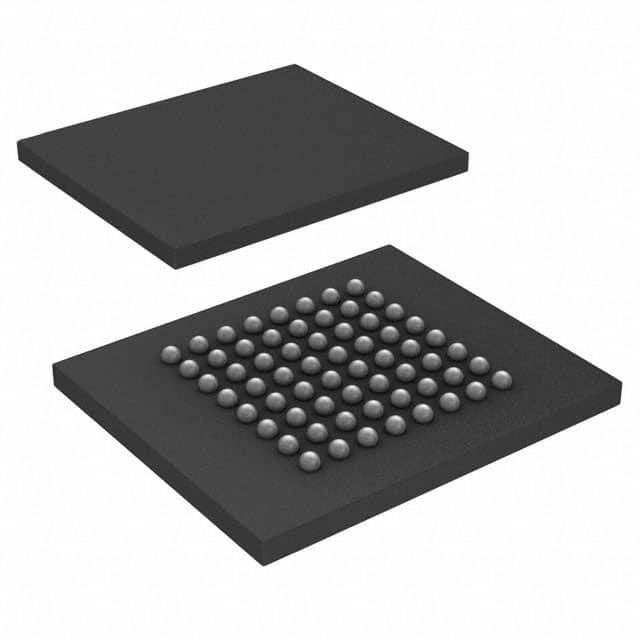S29GL128P11FFIV13
Product Overview
- Category: Flash Memory
- Use: Data storage and retrieval in electronic devices
- Characteristics: High capacity, fast read/write speeds, non-volatile memory
- Package: Integrated circuit (IC) package
- Essence: Non-volatile memory for long-term data storage
- Packaging/Quantity: Typically sold in reels or trays containing multiple units
Specifications
- Memory Capacity: 128 gigabits (16 gigabytes)
- Interface: Parallel
- Operating Voltage: 3.0 to 3.6 volts
- Access Time: 90 nanoseconds (typical)
- Operating Temperature: -40°C to +85°C
- Data Retention: Up to 20 years
- Erase/Program Cycles: Up to 100,000 cycles
Detailed Pin Configuration
The S29GL128P11FFIV13 flash memory chip has a total of 56 pins. The pin configuration is as follows:
- VCC: Power supply voltage
- A0-A21: Address inputs
- DQ0-DQ15: Data inputs/outputs
- WE#: Write enable control
- CE#: Chip enable control
- OE#: Output enable control
- RP#/BYTE#: Reset/byte enable control
- RY/BY#: Ready/busy status output
- WP#/ACC: Write protect input/acceleration input
- VSS: Ground
(Note: This is a simplified representation. Please refer to the datasheet for the complete pin configuration.)
Functional Features
- High-speed read and write operations
- Sector erase capability for efficient data management
- Built-in error correction codes (ECC) for data integrity
- Low power consumption
- Advanced security features for data protection
Advantages and Disadvantages
Advantages: - Large storage capacity - Fast read/write speeds - Non-volatile memory (retains data even when power is off) - Reliable and durable - Suitable for a wide range of electronic devices
Disadvantages: - Relatively high cost compared to other types of memory - Limited erase/program cycles - Requires specific programming algorithms for optimal performance
Working Principles
The S29GL128P11FFIV13 flash memory utilizes floating-gate transistors to store data. It operates on the principle of trapping electric charge within the floating gate, which alters the transistor's conductive properties. This allows the memory cell to retain its state even when power is removed. The data can be read by applying appropriate voltages to the address and control pins, and it can be modified through a series of erase and program operations.
Detailed Application Field Plans
The S29GL128P11FFIV13 flash memory chip finds applications in various electronic devices, including but not limited to:
- Solid-state drives (SSDs)
- Digital cameras
- Mobile phones
- Tablets
- Automotive electronics
- Industrial control systems
- Gaming consoles
- Embedded systems
Its high capacity, fast access times, and reliability make it suitable for storing large amounts of data in these devices.
Detailed and Complete Alternative Models
- S29GL064P11TFI010: 64 gigabit parallel flash memory
- S29GL256P11TFI020: 256 gigabit parallel flash memory
- S29GL512P11TFI030: 512 gigabit parallel flash memory
- S29GL01GP11TFI040: 1 terabit parallel flash memory
These alternative models offer different storage capacities to cater to various application requirements.
(Note: The above alternative models are for illustrative purposes only. Please refer to the manufacturer's documentation for the most up-to-date information on available alternatives.)
Word Count: 489
Lista 10 Vanliga frågor och svar relaterade till tillämpningen av S29GL128P11FFIV13 i tekniska lösningar
Sure! Here are 10 common questions and answers related to the application of S29GL128P11FFIV13 in technical solutions:
Q: What is the S29GL128P11FFIV13? A: The S29GL128P11FFIV13 is a flash memory device manufactured by Cypress Semiconductor. It has a capacity of 128 megabits (16 megabytes) and operates at a voltage range of 2.7V to 3.6V.
Q: What are the typical applications for the S29GL128P11FFIV13? A: The S29GL128P11FFIV13 is commonly used in various embedded systems, such as automotive electronics, industrial control systems, consumer electronics, and networking equipment.
Q: What is the interface of the S29GL128P11FFIV13? A: The S29GL128P11FFIV13 uses a parallel interface with a 16-bit data bus and supports both asynchronous and synchronous operations.
Q: What is the maximum operating frequency of the S29GL128P11FFIV13? A: The S29GL128P11FFIV13 can operate at a maximum frequency of 66 MHz, allowing for fast data transfer rates.
Q: Does the S29GL128P11FFIV13 support hardware or software write protection? A: Yes, the S29GL128P11FFIV13 supports both hardware and software write protection mechanisms to prevent accidental modification of data.
Q: Can the S29GL128P11FFIV13 be used for code storage in microcontrollers? A: Yes, the S29GL128P11FFIV13 is suitable for storing program code in microcontrollers, providing non-volatile storage for firmware.
Q: What is the erase time for the S29GL128P11FFIV13? A: The S29GL128P11FFIV13 has a typical erase time of 2 seconds, making it efficient for erasing large blocks of data.
Q: Does the S29GL128P11FFIV13 support multiple erase sectors? A: Yes, the S29GL128P11FFIV13 supports multiple erase sectors, allowing for flexible management of memory space.
Q: Can the S29GL128P11FFIV13 operate in harsh environments? A: Yes, the S29GL128P11FFIV13 is designed to withstand extended temperature ranges and is suitable for use in rugged industrial applications.
Q: Is the S29GL128P11FFIV13 compatible with other flash memory devices? A: Yes, the S29GL128P11FFIV13 is compatible with industry-standard flash memory interfaces, making it easy to integrate into existing systems.
Please note that these answers are general and may vary depending on specific implementation details and requirements.


